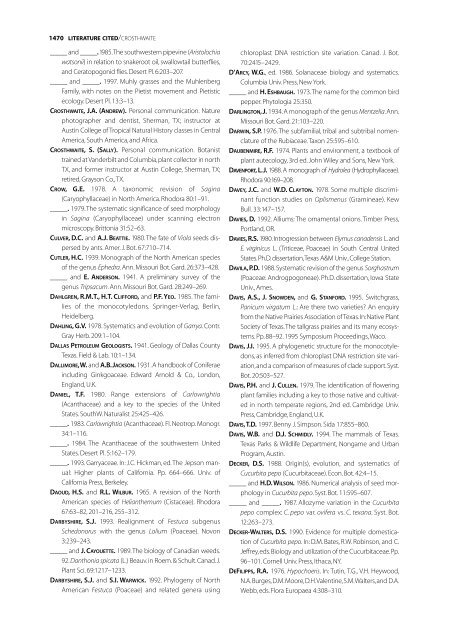References - Botanical Research Institute of Texas
References - Botanical Research Institute of Texas
References - Botanical Research Institute of Texas
You also want an ePaper? Increase the reach of your titles
YUMPU automatically turns print PDFs into web optimized ePapers that Google loves.
1470 LITERATURE CITED/CROSTHWAITE<br />
_____ and _____.1985.The southwestern pipevine (Aristolochia<br />
watsonii) in relation to snakeroot oil, swallowtail butterflies,<br />
and Ceratopogonid flies. Desert Pl. 6:203–207.<br />
_____ and _____. 1997. Muhly grasses and the Muhlenberg<br />
Family, with notes on the Pietist movement and Pietistic<br />
ecology. Desert Pl. 13:3–13.<br />
CROSTHWAITE, J.A.(ANDREW). Personal communication. Nature<br />
photographer and dentist, Sherman, TX; instructor at<br />
Austin College <strong>of</strong> Tropical Natural History classes in Central<br />
America, South America, and Africa.<br />
CROSTHWAITE, S. (SALLY). Personal communication. Botanist<br />
trained at Vanderbilt and Columbia,plant collector in north<br />
TX, and former instructor at Austin College, Sherman, TX;<br />
retired, Grayson Co.,TX.<br />
CROW, G.E. 1978. A taxonomic revision <strong>of</strong> Sagina<br />
(Caryophyllaceae) in North America. Rhodora 80:1–91.<br />
_____. 1979.The systematic significance <strong>of</strong> seed morphology<br />
in Sagina (Caryophyllaceae) under scanning electron<br />
microscopy. Brittonia 31:52–63.<br />
CULVER,D.C.and A.J. BEATTIE. 1980. The fate <strong>of</strong> Viola seeds dispersed<br />
by ants. Amer. J. Bot. 67:710–714.<br />
CUTLER,H.C.1939. Monograph <strong>of</strong> the North American species<br />
<strong>of</strong> the genus Ephedra.Ann. Missouri Bot. Gard. 26:373–428.<br />
_____ and E. ANDERSON. 1941. A preliminary survey <strong>of</strong> the<br />
genus Tripsacum.Ann. Missouri Bot. Gard. 28:249–269.<br />
DAHLGREN,R.M.T., H.T. CLIFFORD, and P.F. YEO. 1985. The families<br />
<strong>of</strong> the monocotyledons. Springer-Verlag, Berlin,<br />
Heidelberg.<br />
DAHLING,G.V.1978. Systematics and evolution <strong>of</strong> Garrya.Contr.<br />
Gray Herb. 209:1–104.<br />
DALLAS PETROLEUM GEOLOGISTS. 1941. Geology <strong>of</strong> Dallas County<br />
<strong>Texas</strong>. Field & Lab. 10:1–134.<br />
DALLIMORE,W. and A.B.JACKSON. 1931.A handbook <strong>of</strong> Coniferae<br />
including Ginkgoaceae. Edward Arnold & Co., London,<br />
England, U.K.<br />
DANIEL, T.F. 1980. Range extensions <strong>of</strong> Carlowrightia<br />
(Acanthaceae) and a key to the species <strong>of</strong> the United<br />
States. SouthW. Naturalist 25:425–426.<br />
_____. 1983. Carlowrightia (Acanthaceae). Fl. Neotrop. Monogr.<br />
34:1–116.<br />
_____. 1984. The Acanthaceae <strong>of</strong> the southwestern United<br />
States. Desert Pl. 5:162–179.<br />
_____. 1993. Garryaceae. In: J.C. Hickman, ed. The Jepson manual:<br />
Higher plants <strong>of</strong> California. Pp. 664–666. Univ. <strong>of</strong><br />
California Press, Berkeley.<br />
DAOUD, H.S.and R.L. WILBUR. 1965. A revision <strong>of</strong> the North<br />
American species <strong>of</strong> Helianthemum (Cistaceae). Rhodora<br />
67:63–82, 201–216, 255–312.<br />
DARBYSHIRE, S.J. 1993. Realignment <strong>of</strong> Festuca subgenus<br />
Schedonorus with the genus Lolium (Poaceae). Novon<br />
3:239–243.<br />
_____ and J. CAYOUETTE. 1989.The biology <strong>of</strong> Canadian weeds.<br />
92. Danthonia spicata (L.) Beauv.in Roem.& Schult.Canad.J.<br />
Plant Sci. 69:1217–1233.<br />
DARBYSHIRE, S.J.and S.I. WARWICK. 1992. Phylogeny <strong>of</strong> North<br />
American Festuca (Poaceae) and related genera using<br />
chloroplast DNA restriction site variation. Canad. J. Bot.<br />
70:2415–2429.<br />
D’ARCY, W.G.,ed. 1986. Solanaceae biology and systematics.<br />
Columbia Univ. Press, New York.<br />
_____ and H. ESHBAUGH. 1973.The name for the common bird<br />
pepper. Phytologia 25:350.<br />
DARLINGTON,J.1934.A monograph <strong>of</strong> the genus Mentzelia.Ann.<br />
Missouri Bot. Gard. 21:103–220.<br />
DARWIN,S.P.1976. The subfamilial, tribal and subtribal nomenclature<br />
<strong>of</strong> the Rubiaceae.Taxon 25:595–610.<br />
DAUBENMIRE, R.F.1974. Plants and environment, a textbook <strong>of</strong><br />
plant autecology, 3rd ed. John Wiley and Sons, New York.<br />
DAVENPORT,L.J.1988. A monograph <strong>of</strong> Hydrolea (Hydrophyllaceae).<br />
Rhodora 90:169–208.<br />
DAVEY,J.C.and W.D. CLAYTON. 1978. Some multiple discriminant<br />
function studies on Oplismenus (Gramineae). Kew<br />
Bull. 33:147–157.<br />
DAVIES,D.1992. Alliums: The ornamental onions. Timber Press,<br />
Portland, OR.<br />
DAVIES,R.S.1980. Introgression between Elymus canadensis L. and<br />
E. virginicus L. (Triticeae, Poaceae) in South Central United<br />
States. Ph.D. dissertation,<strong>Texas</strong> A&M Univ., College Station.<br />
DAVILA,P.D.1988.Systematic revision <strong>of</strong> the genus Sorghastrum<br />
(Poaceae: Androgpogoneae). Ph.D. dissertation, Iowa State<br />
Univ., Ames.<br />
DAVIS,A.S., J. SNOWDEN, and G. STANFORD. 1995. Switchgrass,<br />
Panicum virgatum L.: Are there two varieties? An enquiry<br />
from the Native Prairies Association <strong>of</strong> <strong>Texas</strong>.In:Native Plant<br />
Society <strong>of</strong> <strong>Texas</strong>.The tallgrass prairies and its many ecosystems.<br />
Pp. 88–92. 1995 Symposium Proceedings,Waco.<br />
DAVIS,J.I.1995. A phylogenetic structure for the monocotyledons,<br />
as inferred from chloroplast DNA restriction site variation,and<br />
a comparison <strong>of</strong> measures <strong>of</strong> clade support.Syst.<br />
Bot. 20:503–527.<br />
DAVIS,P.H.and J. CULLEN. 1979. The identification <strong>of</strong> flowering<br />
plant families including a key to those native and cultivated<br />
in north temperate regions, 2nd ed. Cambridge Univ.<br />
Press, Cambridge, England, U.K.<br />
DAVIS,T.D. 1997. Benny J. Simpson. Sida 17:855–860.<br />
DAVIS,W.B. and D.J. SCHMIDLY. 1994. The mammals <strong>of</strong> <strong>Texas</strong>.<br />
<strong>Texas</strong> Parks & Wildlife Department, Nongame and Urban<br />
Program, Austin.<br />
DECKER, D.S.1988. Origin(s), evolution, and systematics <strong>of</strong><br />
Cucurbita pepo (Cucurbitaceae). Econ. Bot. 42:4–15.<br />
_____ and H.D. WILSON. 1986. Numerical analysis <strong>of</strong> seed morphology<br />
in Cucurbita pepo.Syst. Bot. 11:595–607.<br />
_____ and _____. 1987. Allozyme variation in the Cucurbita<br />
pepo complex: C. pepo var. ovifera vs. C. texana. Syst.Bot.<br />
12:263–273.<br />
DECKER-WALTERS, D.S.1990. Evidence for multiple domestication<br />
<strong>of</strong> Cucurbita pepo. In: D.M. Bates, R.W. Robinson, and C.<br />
Jeffrey,eds.Biology and utilization <strong>of</strong> the Cucurbitaceae.Pp.<br />
96–101. Cornell Univ. Press, Ithaca, NY.<br />
DEFILIPPS, R.A.1976. Hypochoeris. In:Tutin, T.G., V.H. Heywood,<br />
N.A.Burges,D.M.Moore,D.H.Valentine,S.M.Walters,and D.A.<br />
Webb, eds. Flora Europaea 4:308–310.
















